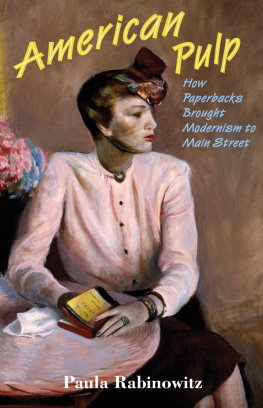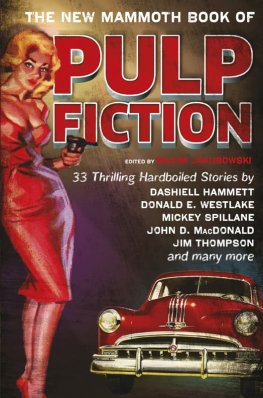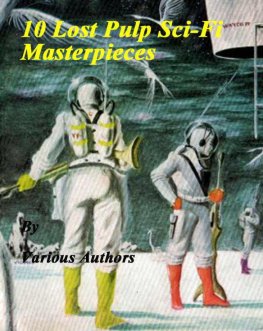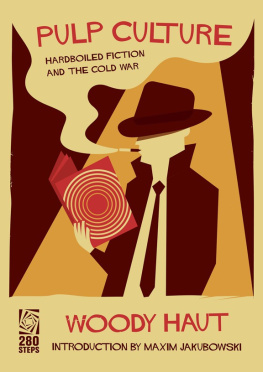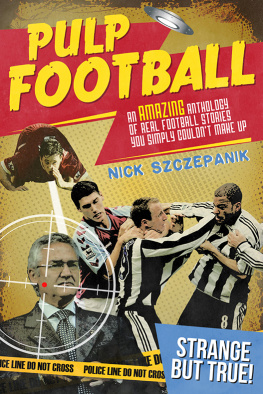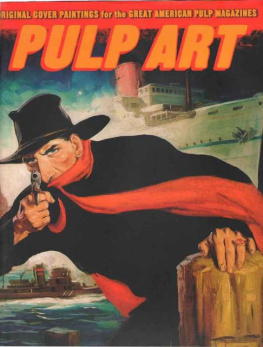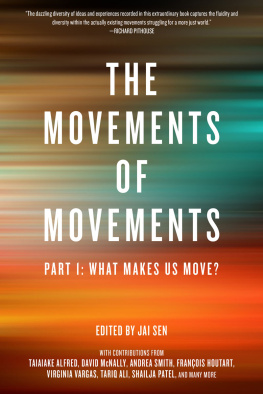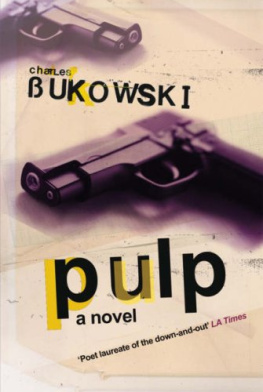Rabinowitz - American Pulp - A History or how Pulp Brought Modernism to Ma
Here you can read online Rabinowitz - American Pulp - A History or how Pulp Brought Modernism to Ma full text of the book (entire story) in english for free. Download pdf and epub, get meaning, cover and reviews about this ebook. year: 2014, publisher: Princeton University Press, genre: Art. Description of the work, (preface) as well as reviews are available. Best literature library LitArk.com created for fans of good reading and offers a wide selection of genres:
Romance novel
Science fiction
Adventure
Detective
Science
History
Home and family
Prose
Art
Politics
Computer
Non-fiction
Religion
Business
Children
Humor
Choose a favorite category and find really read worthwhile books. Enjoy immersion in the world of imagination, feel the emotions of the characters or learn something new for yourself, make an fascinating discovery.
- Book:American Pulp - A History or how Pulp Brought Modernism to Ma
- Author:
- Publisher:Princeton University Press
- Genre:
- Year:2014
- Rating:3 / 5
- Favourites:Add to favourites
- Your mark:
- 60
- 1
- 2
- 3
- 4
- 5
American Pulp - A History or how Pulp Brought Modernism to Ma: summary, description and annotation
We offer to read an annotation, description, summary or preface (depends on what the author of the book "American Pulp - A History or how Pulp Brought Modernism to Ma" wrote himself). If you haven't found the necessary information about the book — write in the comments, we will try to find it.
Rabinowitz: author's other books
Who wrote American Pulp - A History or how Pulp Brought Modernism to Ma? Find out the surname, the name of the author of the book and a list of all author's works by series.
American Pulp - A History or how Pulp Brought Modernism to Ma — read online for free the complete book (whole text) full work
Below is the text of the book, divided by pages. System saving the place of the last page read, allows you to conveniently read the book "American Pulp - A History or how Pulp Brought Modernism to Ma" online for free, without having to search again every time where you left off. Put a bookmark, and you can go to the page where you finished reading at any time.
Font size:
Interval:
Bookmark:

American Pulp
American Pulp
HOW PAPERBACKS BROUGHT MODERNISM TO MAIN STREET
Paula Rabinowitz
PRINCETON UNIVERSITY PRESS
PRINCETON AND OXFORD
Copyright 2014 by Princeton University Press
Published by Princeton University Press, 41 William Street, Princeton, New Jersey 08540
In the United Kingdom: Princeton University Press, 6 Oxford Street, Woodstock, Oxfordshire OX20 1TW
press.princeton.edu
Cover art: Guy Pne Du Bois, Portia in a Pink Blouse, 1942. Indianapolis Museum of Art, gift of Mrs. Booth Tarkington, 62.3. Estate of Guy Pne Du Bois, courtesy of GRAHAM, James Graham & Sons, New York.
Use of Richard Wrights photograph and notes: Copyright 1941 by Richard Wright; Copyright 2014 by The Estate of Richard Wright. Reprinted by permission of John Hawkins & Associates, Inc., and the Estate of Richard Wright.
All Rights Reserved
ISBN 9780-691150604
Library of Congress Control Number: 2014935810
British Library Cataloging-in-Publication Data is available
This book has been composed in Garamond Premier Pro and Van Dijk
Printed on acid-free paper
Printed in the United States of America
10 9 8 7 6 5 4 3 2 1
For my father and the memory of my mother, whose bookshelves were full of pulp.
Focus on the tragic melancholy of the bright stare
Into nowhere, a hole like the black holes in space.
In bra and panties she sidles to the window:
Zip! Up with the blind. A fragile street scene offers itself,
With wafer-thin pedestrians who know where they are going.
The blind comes down slowly, the slats are slowly tilted up.
Why must it always end this way?
A dais with woman reading, with the ruckus of her hair
And all that is unsaid about her pulling us back to her, with her
Into the silence that night alone cant explain.
Silence of the library, of the telephone with its pad
John Ashbery, Forties Flick
Contents
Preface
Its hard to pin down the exact date when print is supposed to have died. Perhaps the summer of 2010, when Amazon announced it had sold more e-books than hardback books and journalist Rob Walker, creator of the Consumed column for the New York Times, saw a future for books as useful raw material for conversion into an impressive variety of artworks. He even located an online tutorial for using the pages of cheap paperback books at the thrift store to make what amounted to wallpaper.
But, of course, it has been more than a decade since 2004, when Google began digitizing whole library collections and independent bookstores fell to Barnes and Noble and Borders; then a few years later, Borders disappeared too.
The Doorway, AMCs April 2013 season-opening episode of the television series Mad Men, began with Don Draper and his young wife, Megan, tanning on Waikiki Beach, the peak of Diamond Head looming in the background. He is reading John Ciardis translation of Dantes Inferno in the 1954 Mentor Classic edition from New American Library. It seems in our electronic age, we must return to that moment in the middle of the last century when bikinis occupied the same blanket as the paperback. Midway in our lifes journey, I went astray, reads Ciardis Dante in a voice-over by Jon Hamm. The series Mad Men tracked the shift from advertising focused on printin magazines, newspapers, and billboardsto another visual media: television. Its explorations of postKorean War social changes in race relations, sexual mores, and family dynamics are mirrored in the advertising worlds confusion about new technologies available to American consumersair travel, television sets, stereo headphones. The Drapers have taken a plane to the Hawaii Hilton in pursuit of new advertising clients and new modes of marketing pleasure, but Don clings to the past. Hes in the middle of his life and he strays.
This conundrum about paper, its recurring disappearance and the attendant anxiety this seems to provoke, is at the heart of American Pulp. How is it that at the very moment when Americans were first entering the age of television, millions and millions of books were being soldand readacross the country? What did these objects offer their postwar readers? And why have these objects maintained such a fascination for scholars and artists, modern effigies of Giovanni Battista Piranesis ruins, but better because as bearers of dust on ones own shelves they can be handled and manipulated, traded and tossed aside. In A Tour of the Monuments of Passaic, New Jersey (1967), earthworks artist Robert Smithson begins his journey into entropy with print: On Saturday, September 30th 1967, I went to the Port Authority Building on 41st Street and 8th Avenue. I bought a copy of the New York Times and a Signet paperback called Earthworks by Brian W. Aldiss. Next I went to ticket booth 21 and purchased a one-way ticket to Passaic. After perusing the newspaper, he
read the blurb and skimmed through Earthworks. The first sentence read: The dead man drifted along in the breeze. It seemed the book was about soil shortage, and the Earthworks referred to the manufacture of artificial soil. The sky over Rutherford was a clear cobalt blue, a perfect Indian summer day, but the sky in Earthworks was a great black and brown shield on which moisture gleamed.
A paperback book about decay, a desiccation that turns dirt to dust, travels across the Hudson, west to New Jersey, toward the further promise of America, spelling out an alternative vision of a landscape glimpsed from a bus window for an artist whose work will transform the land.
American Pulp is about the kind of paperback books that sat on my mothers nightstand all through my childhood. Books with slightly risqu covers. Books like Harrison E. Salisburys The Shook-Up Generation, which featured a picture of New York City juvenile delinquents on its cover, or Boris Pasternaks Dr. Zhivago. Or any of the many hundreds of books reprinted by the New American Library of World Literature that sold for a quarter or thirty-five cents during the 1950s and early 1960s. Pasternaks novel was the first long book I read the summer after sixth grade. Id lie in the grass in the backyard of our suburban New Jersey house with the paperback I had taken from her nightstand, pretending I understood it, and thus, to some extent, my mother, but all the while paging frequently to the back where the catalog of proper names and diminutives was listed to remember who was who. That book has disappeared, yet I am still fascinated by those evocative tokens of my girlhood, a girlhood spent wishing I were a grown-up like the ones on the books covers. Ive spent a lifetime collecting these disintegrating books, first by lifting them from my parents shelves, then by shuffling through piles of junk at used bookstores, Salvation Army shops, or yard sales, and now by searching on AbeBooks.com.
I was supposed to finish American Pulp in 2012, the year my mother died, but I couldnt. The books, which appealed to me once as cheap icons of maturity (as both literary works and smutty objects), with their brittle, mossy pages, now feel like corpses. They were, of course, meant to pass away: the paper of poor quality, the bindings barely holding the pages, the covers prone to puckers, rips, and tears. They speak to me of my mothers death, of the deaths of all those like her: smart women who made it out of the Depression and into the bright world of 1950s suburbia, who had high intellectual pretensions but little money, whose habits of reading were forged in the public library, and who were now stuck at home with young children and confined by domestic life. In his brief history of the New American Library, Richard J. Crohn quotes from a letter he received from a midwestern housewife: If you knew how bored I get looking after two small children, doing housework, and seeing the same old neighbors day after day, youd understand what a godsend your inexpensive books have been. I never knew that books These paperbacks, like any book, offered escapes to worlds far from the tedium of houseworkbut they offered something more. They were theirs, to be owned, collected, accumulating on shelves waiting to be dusted.
Next pageFont size:
Interval:
Bookmark:
Similar books «American Pulp - A History or how Pulp Brought Modernism to Ma»
Look at similar books to American Pulp - A History or how Pulp Brought Modernism to Ma. We have selected literature similar in name and meaning in the hope of providing readers with more options to find new, interesting, not yet read works.
Discussion, reviews of the book American Pulp - A History or how Pulp Brought Modernism to Ma and just readers' own opinions. Leave your comments, write what you think about the work, its meaning or the main characters. Specify what exactly you liked and what you didn't like, and why you think so.

